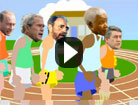 This book is better known as Primal Leadership. Inexplicably, given the power of that title, the publisher in the UK decided to label it The New Leaders (yawn).
This book is better known as Primal Leadership. Inexplicably, given the power of that title, the publisher in the UK decided to label it The New Leaders (yawn).
Daniel Goleman and his co-authors Richard Boyatzis and Annie McKee helped pioneer the now accepted idea that leaders don’t get effective results with logic alone, and that they need to deploy Emotional Intelligence to get the best out of people and organizations…and themselves.
Here are selected excerpts to give you a flavour:
“For too long managers have seen emotions at work as noise cluttering the rational operation of organizations. But the time for ignoring emotions as irrelevant to business has passed. What organizations everywhere need now is to realize the benefits of primal leadership by cultivating leaders who generate the emotional resonance that lets people flourish.”
Primal Leadership Definition
This emotional task of the leader is primal – that is, first – in two senses: It is both the original and the most important act of leadership.”
Resonance vs Dissonance
When leaders drive emotions positively we call this effect resonance. When they drive emotions negatively, leaders spawn dissonance, undermining the emotional foundations that let people shine. Whether an organization withers or flourishes depends to a remarkable extent on the leaders’ effectiveness in this primal emotional dimension.”
Laughter: the shortest distance between two people
(NB As far as I know, Goleman took that line from stand-up comedian Victor Borge).
“In a neurological sense, laughing represents the shortest distance between two people because it instantly interlocks limbic systems. This immediate, involuntary reaction, as one researcher puts it, involves “the most direct communication possible between people – brain to brain – with our intellect just going for the ride, in what might be called a ‘limbic lock’.”
Leadership, not leader
As the sociologist Max Weber argued a century ago, institutions that endure thrive not because of one leader’s charisma, but because they cultivate leadership throughout the system.
Changes to the EI model
“Readers familiar with earlier versions of the EI model will notice some changes here. Where we formerly listed five main domains of EI, we now have simplified the model into four domains – self-awareness, self-management, social awareness, and relationship management – with eighteen competencies instead of the original twenty-five (see the chart). For instance, an EI domain would be social awareness; a competency in that domain would be empathy or service. The result is an emotional intelligence model that more clearly links specific clusters of competencies to the underlying brain dynamics that drive them.”
EI CAN be learnt
“These EI competencies are not innate talents, but learned abilities, each of which has a unique contribution to making leaders more resonant, and therefore more effective.
That fact speaks to an urgent business need, one with great impact on financial results: helping leaders to lead more effectively.”









Leave a Reply